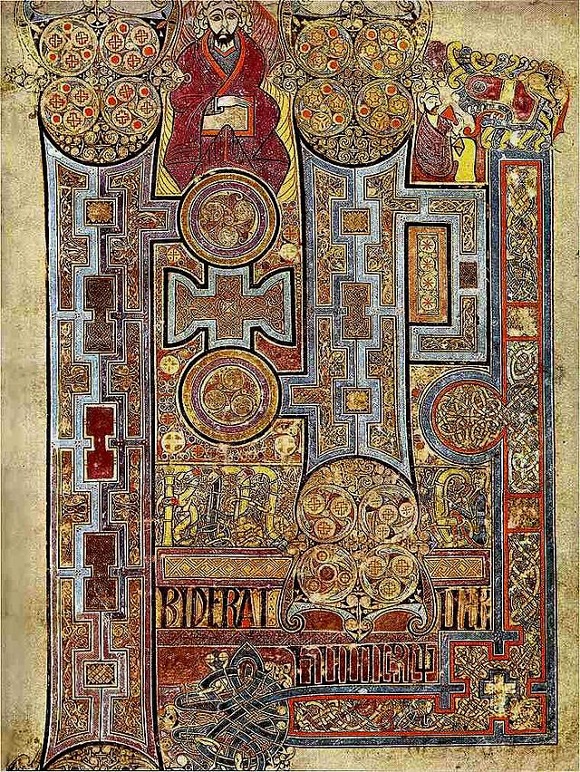Dubliners Contents
More on Early Irish history, 400 - 1485
More on Early Irish history, 400 – 1485
Before the Vikings: the fifth to the ninth centuries

In about 420 CE St Patrick brought Christianity to Ireland. The fifth and sixth centuries saw the foundation of a number of monasteries, led by a number of charismatic figures such as St Finnian, St Ciaran, St Brendan and St Columba, who took Christianity to Scotland.
These monasteries became powerful centres of faith and culture and exerted the influence of Celtic Christianity, and the art associated with it, throughout Europe. During the seventh and eighth centuries Irish monks created wonderful illuminated manuscripts – usually of the four Gospels from the New Testament – with fine calligraphy, intricate decorative patterns and delightful illustrations. The best known of these, the Book of Kells, was made during the ninth century.
The Vikings and the Norwegians
Viking raids on the Irish mainland and the islands around both Ireland and Scotland began at the end of the eighth century. Initially, the invaders were largely interested in the wealth and treasures accumulated by the monasteries. During the ninth century, however, the Viking raiders began to settle and control the Scottish islands and the Isle of Man, and were beginning to conquer territory in Britain and Ireland.
In 838 Norwegians captured Dublin and established a Norse kingdom in and around the city. However, for the next two centuries the Irish people continued to resist the invaders. In 1014, under the leadership of Brian Boru, King of Ireland since 1002, the Vikings were defeated at the Battle of Clontarf. Although this meant that the Vikings were prevented from increasing their territory and power in Ireland, both Brian and his son died in the battle. With no obvious successor to the kingship, the Irish were confused and disunited.
Normans and English in the twelfth century
England had been conquered by the Normans under William 1 (who reigned 1066-87). Land-hungry Normans living in Wales (many of them vassals of the Earl of Pembroke, known as ‘Strongbow’) invaded Ireland in 1169, winning territory from the Vikings. An appeal for help from the Earl of Leinster, a dispossessed Irish nobleman, provided an opportunity for Strongbow to land in Ireland. By the end of 1170, Dublin had been captured by the Normans, after being in Viking hands for over three hundred years.
Henry II (who reigned 1154-1189) landed in Ireland with a large army in 1171. He wanted to ensure that the territorial gains made by the Norman adventurers came under his control. In addition, it was believed that the Pope had granted him authority over Ireland in order to reform the Irish church and bring it under the control of Rome. Eventually, both the Norman and the Irish lords paid homage to Henry, thus acknowledging his right to a presence in Ireland.
During the seven months he spent in Ireland, Henry established feudal rule but, although the country was now under the rule of the English crown, the immediate source of power lay in the powerful Norman families. They soon began to intermarry with the indigenous Celtic people to establish a group known as the Anglo-Irish.
English Government and Celtic resistance 1210-1318
During the next century English control over Ireland was often only nominal. On 1210 King John (reigned 1199-1216) visited Ireland and tried to establish a governmental structure similar to that in England. But it was only in 1297 (during the reign of Edward I, 1272-1307) that the first Irish parliament met in Dublin, followed by a second session in 1300, and its grasp on power beyond the immediate locality of Dublin remained tenuous.
In 1314 the Scots defeated the English at the Battle of Bannockburn and in the wake of this great victory the Irish hoped that they might similarly succeed in resisting English rule. Edward, younger brother of Robert the Bruce (the new king of Scotland), invaded Ireland in 1315 and at first made good progress. He was crowned king of Ireland in 1316 but, in spite of being joined by his brother with further forces in 1317, he never managed to capture Dublin, the centre of English power. In 1318 he was killed in battle, at which point the uprising came to an end.
The three earls: the fourteenth and fifteenth centuries
In response to Edward Bruce’s uprising, the next two English kings (Edward II, 1307-27 and Edward III 1327-77) created three earldoms: Kildare in 1316, Ormonde in 1328 and Desmond in 1329. All three were granted to members of powerful Anglo-Irish families, and by the fifteenth century they had control of southern Ireland. The area immediately around Dublin, called the Pale, remained under the rule of a Lord Deputy who was the direct representative of the English monarch. However, since this post was frequently held by one of the earls, Anglo-Irish rule was also present in the capital.